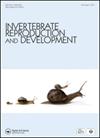An equation for geometric progression in Brooks-Dyar growth ratios
IF 0.8
4区 生物学
Q4 REPRODUCTIVE BIOLOGY
引用次数: 2
Abstract
ABSTRACT The Brooks-Dyar rule predicts a geometric progression in the growth increments of successive instars. Although these increments are readily calculated as ratios, analysis of the relationship between these ratios has been more problematic. In the early twentieth century, the use of logarithms was proposed as a method for calculating the equation of the line. This is as close to a standardized method of analysis that the ratios have come in entomology. It is argued here: (a) that a log scale is a misleading and misunderstood criterion in this context because growth increments do not span multiple orders of magnitude; and (b) a straight-line is an inappropriate mode of representation for growth patterns that are discontinuous. Moreover, the transformation does not provide any means for quantifying the degree of geometric progression. A simple exponential equation can be applied easily to any ratio data set to provide a more realistically curved plot of growth increments. A property of geometric progression sequences (b2 = ac) can be utilized to provide an equation for evaluating the degree of geometric progression in development. Transformations are replaced by greater biological realism and a precise method of quantifying agreement with Brooks-Dyar’s rule.Brooks-Dyar增长率的几何级数方程
摘要Brooks-Dyar规则预测了连续龄期的生长增量呈几何级数。尽管这些增量很容易被计算为比率,但对这些比率之间关系的分析问题更大。在二十世纪初,对数被提出作为计算直线方程的一种方法。这与昆虫学中的比率一样接近于标准化的分析方法。这里有人认为:(a)在这种情况下,对数尺度是一个误导和误解的标准,因为增长增量不会跨越多个数量级;以及(b)对于不连续的生长模式,直线是不合适的表示模式。此外,该变换没有提供任何用于量化几何级数的手段。简单的指数方程可以很容易地应用于任何比率数据集,以提供更真实的增长增量曲线图。几何级数(b2=ac)的性质可以用来提供用于评估展开中的几何级数的方程。转换被更大的生物学现实主义和与Brooks-Dyar规则一致的精确量化方法所取代。
本文章由计算机程序翻译,如有差异,请以英文原文为准。
求助全文
约1分钟内获得全文
求助全文
来源期刊
CiteScore
1.90
自引率
0.00%
发文量
21
审稿时长
>12 weeks
期刊介绍:
Invertebrate Reproduction & Development ( IRD) presents original research on the reproductive and developmental biology of the Invertebrata, both embryonic and postembryonic. IRD welcomes papers reporting significant results obtained using new techniques. Encouraged topic areas include: aquaculture, physiology, biochemistry, functional morphology, phylogeny, behavioural and regulatory mechanisms, including genetic, endocrine and molecular studies. Papers containing qualitative descriptions of reproductive cycles and gametogenesis will not be considered. IRD is published in association with the International Society of Invertebrate Reproduction and Development.

 求助内容:
求助内容: 应助结果提醒方式:
应助结果提醒方式:


